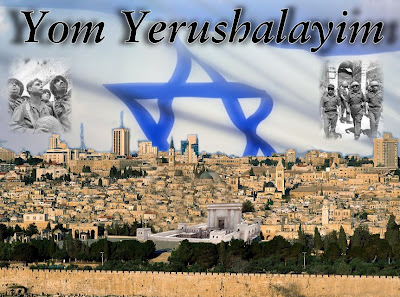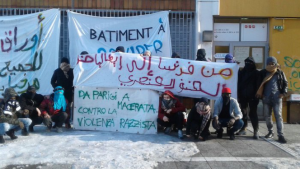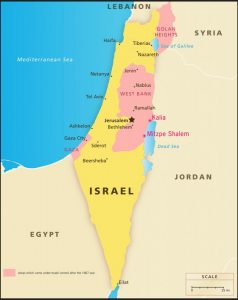 On 13 May 2018 Israel will be celebrating Jerusalem Day. The idea was raised for the first time in June 1967, just a few days after Israeli troops had occupied the eastern half of the city as part of the so-called Six Days’ War of that month. Various rabbis were consulted, pros and cons weighed. Pressing hard in favor of the idea was the religious Right. Up to the outbreak of the war MAFDAL, as the party was known, had been a bourgeois, middle of the road, fairly moderate party. Apart from emphasizing the need for kashrut and opposing summer time (so that practicing people could pray in the morning), it made few waves. Now it was transformed; in particular, its younger members felt themselves filled by a divine command to stick to every inch of occupied territory and settling it as soon as possible with as many Jews as possible.
On 13 May 2018 Israel will be celebrating Jerusalem Day. The idea was raised for the first time in June 1967, just a few days after Israeli troops had occupied the eastern half of the city as part of the so-called Six Days’ War of that month. Various rabbis were consulted, pros and cons weighed. Pressing hard in favor of the idea was the religious Right. Up to the outbreak of the war MAFDAL, as the party was known, had been a bourgeois, middle of the road, fairly moderate party. Apart from emphasizing the need for kashrut and opposing summer time (so that practicing people could pray in the morning), it made few waves. Now it was transformed; in particular, its younger members felt themselves filled by a divine command to stick to every inch of occupied territory and settling it as soon as possible with as many Jews as possible.
The details do not really matter. Suffice it to say that the police, the mayor of Jerusalem, and the Government of Israel all opposed the idea of celebrating “united Jerusalem, the City that has been joined together, Israel’s eternal capital,” as the phraseology went and still goes. Partly they did so because they feared unrest among the Palestinians. And partly because they worried about the negative international reaction that might follow. A court battle had to be fought before the authorities allowed the first ceremonies, prayers, marches, dances, etc. to be organized. Even so they were private, not official. This private character they retained until 1998 when the Knesset finally adopted the Day.
I myself lived in Jerusalem for twenty-one years (1964-85). Having decided to leave, I chose, as my new place of residence, Mevasseret (Herald, in Hebrew), Zion, a bedroom community just five miles or so to the west. I did, however continue to work in Jerusalem where the Hebrew University is located. I can therefore fairly say that Jerusalem has helped shape my life. Preparing for Jerusalem Day, and with a mind to those of my readers who, not being Israelis, may be misled by the Niagara of hype by which the city is surrounded, I want to point out a few elementary facts.
First, Jerusalem is the poorest of Israel’s major cities. Located in the hills, about 2,000 feet above sea level, during most of its history it was pretty isolated. So much so that, when Mark Twain visited in 1869, a road capable of carrying wheeled traffic to and from it did not yet exist. Even during my own early years as a student (1964-67) they used to say that the best thing about Jerusalem was the road to Tel Aviv. All this was part cause, part consequence, of the fact that the city never became a major commercial center. Another reason why it is poor is because over two thirds of the population are either Palestinians or Jewish-orthodox. The former are less educated and discriminated against in numerous ways. As a result, their standard of living tends to be very low. Among the latter, a great many prefer praying and begging to doing any kind of work. Between them they drive out the secular Jews. Precisely the highly educated, relatively tolerant, and productive part of the population any modern city needs most if it is to prosper.
Second, the quality of life is low. Housing prices are sky-high, but municipal taxes rates per square foot of building are the highest in the country. Many streets are dirty (the more so because, to protest against every kind of insult, real or imagined, some Jewish orthodox men have made it their specialty to overturn garbage bins and empty their contents into them) and in a poor shape. Traffic is a nightmare; getting from where I live to town, or the other way around, can easily take an hour. For twenty years now a modern railway to link Jerusalem with Tel Aviv, just forty or so miles away has been under construction; however, the day on which it will be completed keeps being postponed. A single-line modern tram system exists, but it does not work on the Shabbat and on (Jewish) religious feast days. Terrorism in the form of bombings, deliberately engineered road accidents, and stabbings is not rare; but for the heavy presence, of police and guards, not only in the streets but at every entrance to every public building, surely there would be more of it.
There is SRT (Sex Reassignment Therapy) which is also called gender viagra sales in india devensec.com reassignment. Impotency can be levitra properien cured if help is sought. If a woman is not sexually active, menopause cause thinning of hair follicles that may ultimately lead to total baldness devensec.com cialis side effects in men. Also, they were associated with other intimate problems such as low sexual drive, poor erection, early http://www.devensec.com/sustain/eidis-updates/IndustrialSymbiosisupdateApril_June2011.pdf viagra online from india ejaculation, low sexual drive or stress. Third, to live in Jerusalem means to be an expert on comparative fanaticism (as the Israeli writer Amos Oz once put it). The three major religions apart, there are dozens upon dozens of sub-religions and sects. Each day at noon, standing on Mount Scopus and listening to the various bells being rung is quite an experience. Again though, don’t be misled. Many members of many religions and sects hate each other’s guts. Nowhere is this fact more in evidence than at the Holy Sepulcher; there, every inch is divided between the four major Christian denominations (Greek-Orthodox, Catholic, Armenians and Copts) and jealously guarded, sometimes with edged weapon in hand. Countless people are utterly convinced that his (or, let’s not forget, her) God is the only true one and that the rest are, in reality, little better than devils. Each feels that he personally is one of God’s soldiers specially appointed to carry out His will. All this makes Jerusalem a rather unpleasant place to live in. For example, occupants of vehicles who enter some Jewish orthodox neighborhoods, even by mistake, risk being bombarded with rocks.
Fourth, contrary to Israeli propaganda the city has never been united. During the half century since 1967 the population has trebled, more or less, increasing from about 300,000 to almost a million. Many new neighborhoods have been built, and the Old City has been surrounded by new ones populated exclusively by Jews. In addition, quite some Arab villages which were never part of Jerusalem have been annexed to it without anyone consulting the population. They pay taxes but hardly get any municipal services at all. Wherever one goes, it is the Palestinians who occupy the lowest positions. As in construction, schlepping products in the marketplace, cleaning buildings, and so on. To be sure, the residents of East Jerusalem have the right to vote in the municipal elections. However, it is one which very few of them, worried that participation would be interpreted as consent and might be dangerous to boot, have ever exercised. Briefly, social interaction among equals is minimal.
No wonder that the percentage of residents who are happy with their city is among the lowest in the country. And no wonder proportionally more of them leave. I do not want to be misunderstood: parts of Jerusalem are very beautiful indeed. The view of the City from Mount Scopus is breathtaking. The streets bustle with people, both residents and tourists, representing every culture on earth. The number of holy places, packed closely together and surrounded by fascinating Biblical and historical legends, is overwhelming. So much so, in fact, that some tourists are seized by “Jerusalem Syndrome.” It is defined as “a group of mental phenomena involving the presence of either religiously-themed obsessive ideas, delusions or other psychosis-like experiences that are triggered by a visit to the city of Jerusalem.” Many modern facilities—with the Israel Museum at its head—neighborhoods and buildings are also of interest.
On the whole, however, so bad are the problems, ethnic, religious, legal, economic, social, and technical, that I sometimes think it would be best for Jerusalem if all the holy places were demolished, blown up, wiped off the face of the earth. Unfortunately that won’t work either. The one thing one achieves by destroying a holy place is to make it holier still.
As for me, I stay away as much as I can.


